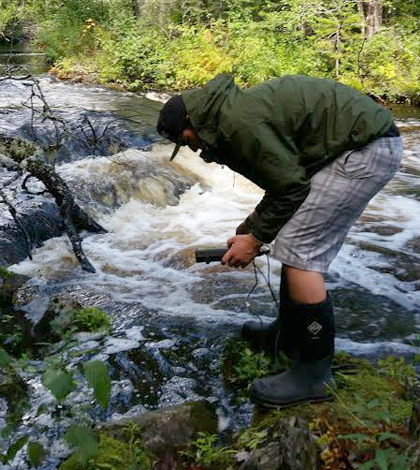Penobscot Indian Nation Safeguards Tribal Waterways

A field technician with the Penobscot Indian Nation uses a pH meter to take stream quality measurements. (Credit: Dan Kusnierz / Penobscot Indian Nation)
Tribal members of the Penobscot Indian Nation have long believed that the Penobscot River was the lifeblood of their people, providing food and transportation needed to support survival. Clearly, keeping water quality good in the river is of concern to natural resource managers with the tribe.
But the Penobscot River is not the only waterway that flows through tribal lands. There is Dolby Pond, a prominent water body in the state of Maine monitored in recent years by a sensor-equipped floating platform, and many other streams and creeks that trickle through the nation’s territories.
For these, natural resource managers make routine trips to monitor their health, relying on significant parameters like temperature, conductivity, dissolved oxygen and pH. A lot of this sampling relies on the use of handheld meters to take measurements directly from a stream.
Visiting the sites and taking manual measurements is an easy way to keep tabs on changes arising in stream conditions. But limitations can come when equipment doesn’t want to cooperate with the mission at hand.
Take the measurement of pH for example. This important parameter is an indicator of acidity, but also can influence other metrics of water quality such as the toxicity of chemicals and metals in water. For that parameter, resource managers with the nation say that some meters have been slow to respond, making them doubt the reliability of the readings they were getting. So they obtained a Thermo Orion Star A221 Portable pH Meter to help.
“In the past we have been frustrated by unstable readings from pH meters and probes that we have used in the field,” said Dan Kusnierz, water resources program manager for the Penobscot Indian Nation. “We find that the A221 with the ROSS probe provides quick and stable readings, which gives us more confidence in the pH values and cuts down on the amount of time we need to spend at each monitoring site.”
All of these sampling sites sit within the Penobscot River watershed, Kusnierz says. Technicians commonly take measurements along the river, its tributaries and lakes and ponds nearby. Other waterways flowing into the Penobscot Indian Nation’s streams also get checked.
In addition to pH, tribal waters get screened for dissolved oxygen, temperature, depth, Secchi disc transparency (clarity) and conductivity. Discrete samples are also sometimes taken back to the lab for analysis of parameters including bacteria, TSS (total suspended solids), phosphorous, chlorophyll a, biochemical oxygen demand, alkalinity and turbidity.
These measurements are important for a number of different reasons, he says.
“We use the data for a variety of purposes including determining whether Tribal or State water quality standards are being met, determining whether dischargers are in compliance with permit limits, characterizing water quality and determining changes that may occur with events such as algal blooms or dam removal,” said Kusnierz.
So far, the implications of the data haven’t been too surprising. All the measurements coming in indicate compliance with water quality standards, he says. As for pH, its levels remain stable in the river throughout summer and early fall.
Top image: A field technician with the Penobscot Indian Nation uses a pH meter to take stream quality measurements. (Credit: Dan Kusnierz / Penobscot Indian Nation)




0 comments